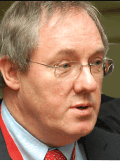Cardiac radiologists confront technological, training issues
The last decade has seen rapid advances in our technological capability to image the heart noninvasively.

The last decade has seen rapid advances in our technological capability to image the heart noninvasively. Fast high-resolution multislice CT has made a huge impact on coronary artery disease diagnosis, and MRI has developed significantly enough to challenge nuclear medicine and echo sonography techniques in the ability to diagnose myocardial ischemia and viability.
Given that cardiac radiologists now have the tools with which they can make an impact on cardiac diagnosis, what challenges remain for this group, and how can they play a greater role in the clinical management of the cardiac patient?
Despite the rapid development of equipment, there are still marked technological challenges in cardiac imaging. All cardiac radiologists would like faster, clearer low-radiation technology in CT and faster, more reliable MRI. Further advances may include software packages that provide a user-friendly interface between the machine, the radiologist, and the clinician that can be translated between imaging environments. This would not only facilitate clinician and patient understanding of the examination, but it would also allow for standardized multicenter trials, which contribute vitally to the knowledge base for noninvasive and in-vasive cardiac research.
Having this knowledge base and the ability to standardize trial data are major strengths of cardiology and need to at least be replicated, if not surpassed, for cardiac radiology to be a serious contender for research funding and for it to grab the attention of governments and EU bodies.
The mainstay of cardiac imaging is 1.5T MRI, but high-field MRI is emerging as the preferred platform for brain imaging, particularly in functional MRI (fMRI). Faster imaging and high signal-to-noise are offset by greater fragility in image quality and more artifacts.
As a research tool, however, high-field cardiac MRI may offer advantages over conventional systems in its ability to image plaques and its greater sensitivity in viability diagnosis and capillary circulation. The development of high-field MRI and research into fMRI techniques for the heart is an exciting area.
Even greater than the technological aspects in cardiac radiology are the training and manpower issues. At the moment, the number of fully trained cardiac radiologists is few compared with the need for trained personnel required to use the technology.
We are rapidly moving into a phase in which the average hospital has the technological capacity to perform high-quality cardiac imaging. To fulfill the potential of this expansion of available equipment and technological development, we will need a rapid expansion in the number of trained cardiac radiologists. The European Society of Cardiac Radiology (ESCR) and the European Society of Radiology (ESR) are already embarking on fellowship programs and teaching courses to prepare the cardiac radiologists of the future. Recognition and acceptance of this training at national and EU levels may be required before the effort can be truly effective. Widening training in cardiac radiology must be a priority for the future.
Trained cardiac radiologists who can provide service reliably and enthusiastically will command the respect and support of their colleagues in clinics and operating theatres. We often refer to these doctors as our “clinical colleagues,” forgetting that what radiologists do is no less clinical and central to patient management. Radiologists need to be integrated into the clinical team and help with the management of the patient. The question should no longer be “what can we image?” but “how should we image?” This will ensure that the workup and treatment of the patient are optimized for the clinical problem at hand.
The ESCR is helping in this process by publishing guidelines that are meant to be of practical use in clinical settings. Building on this process, we will be consulting with other cardiac imaging societies to produce consensus documents giving guidance on patient management. Recognition of training in cardiac radiology at centers of excellence and in teaching courses is another vital step in the development of the specialty.
Cardiac radiologists are starting to work more closely with our technical colleagues. A large number of physicists and other scientists now come to our meetings. The ESCR will be hosting joint sessions with radiographers starting at its annual meeting in Leipzig in October 20009. Everyone is welcome to attend that meeting.
What New Lung MRI Research Reveals About Post-COVID-19 Conditions in Children and Adolescents
February 25th 2025Adolescents with post-COVID-19 conditions had 37 percent lower quantified lung perfusion than healthy control participants on phase-resolved functional lung MRI, according to findings from a recent prospective study.